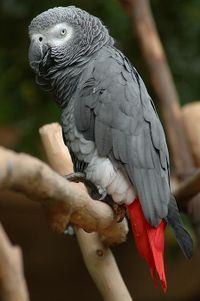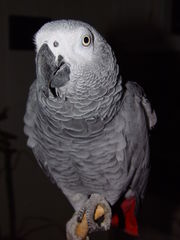African Grey Parrot
Conservation status: Least concern |

Congo African Grey Parrot
Psittacus erithacus erithacus
|
|
Scientific classification |
| Kingdom: |
Animalia
|
| Phylum: |
Chordata
|
| Class: |
Aves
|
| Order: |
Psittaciformes
|
| Family: |
Psittacidae
|
| Genus: |
Psittacus
|
| Species: |
P. erithacus
|
|
|
Binomial name |
Psittacus erithacus
Linnaeus,
1758 |
| Subspecies |
P. e. erithacus
P. e. timneh |
The African Grey Parrot is a medium-sized parrot
of the genus Psittacus, native to
Africa. As the name implies, they are predominantly grey,
with accents of white. Some of their feathers are very dark
grey and others are a lighter grey colour. They have red or
maroon tails depending on the subspecies. They feed primarily on nuts and fruits,
supplemented by leafy matter.
Subspecies
There are two subspecies:
- Congo African Grey parrot, Psittacus erithacus
erithacus - these are larger birds (about 12
inches/30cm long) with light grey feathers, deep red
tails and black beaks.
- Timneh African Grey parrot, Psittacus erithacus
timneh - these are smaller in size, have a darker
charcoal gray coloring, a darker maroon tail, and a
light, horn colored upper mandible.
Some avian enthusiasts (incorrectly) recognize a third
subspecies, Ghana African Grey (Psittacus erithacus
princeps). This bird is described to be similar to the
Congo African greys, but darker and slightly smaller;
however, scientifically this subspecies has not been found.
Among breeders, there is said to be a fourth subspecies, the
Cameroon African Grey, most often referred to as the big
silvers.
Mimicry and intelligence

Congo African Grey Parrot
While comparative judgements of animal intelligence are
always very difficult to make objectively, Psittaciformes are generally regarded as being the most
intelligent of
birds. African grey parrots are particularly noted for
their
cognitive abilities, which are believed to have evolved as a
consequence of their history of cooperative feeding on the ground in central Africa.
Irene Pepperberg's extensively published research with
captive African greys, including Alex, has shown that these
parrots are capable of associating human words with their
meanings, at least to some extent. Ambitious claims of
language use have also been made for another African grey
N'kisi, who has a vocabulary of over a thousand words
and speaks in sentences. However, there is little doubt that Greys and other parrots (especially
macaws and
cockatoos), along with corvines (Crows,
Ravens, and
Jays),
are highly intelligent in comparison with other birds.
African Grey Parrots as Pets
The history of African Grey parrots kept as pets dates
back over 4,000 years. Some Egyptian hieroglyphics clearly
depict pet parrots. The ancient Greeks also valued parrots
as pets, and this custom was later adopted by the Wealthy
Roman families often kept parrots in ornate cages, and
parrots were prized for their ability to talk. King Henry
VIII of England also had an African Grey
parrot. The Portuguese sailors kept them as companions on
their long sea voyages.
Today, many African Grey parrots are hand reared by
breeders for the pet trade and they make wonderful and very
affectionate
companion parrots; however, because they can be
unpredictable at times, they may not be compatible with
small children. African Grey parrots are very strong and
they can bite with their strong pointed beak and scratch
with their claws. African Grey parrots have a high
intelligence and they are generally thought to be the best
mimics of all parrots. Pet owners often refer to their
relationship with their hand reared pet African Greys as
being "like having a five-year-old child". On the other
hand, wild-caught African Grey parrots captured from the
wild need time and effort to adapt to human presence, and
have a tendency to growl and bite when they are approached.
The Convention on the International Trade in Endangered
Species (CITES)
has made the sale of all wild caught parrot species illegal.
African Grey parrots, like any pet parrot, can require a
large commitment as they require a lot of attention. While
numbers vary with each source, most agree that three hours
out of cage daily and 45 minutes of physical interaction is
the minimum attention required for good mental health.
African Greys – particularly Congo African Greys – are known
to be shy amongst strangers. African Greys have the tendency
to bond to only one person if they do not interact with
different people regularly. While inter-species friendships
with other parrots are uncommon with African Greys, they
require socialization with other parrots of any species.
African Greys require a lot of stimulating toys due to
their high intelligence and to avoid boredom. Three to five
toys at a time are typically enough to satisfy African
Greys, but too many toys can crowd the cage. Toys should be
rotated and switched regularly to keep the stimulation
constant and diverse. For an African Grey spending most of
its day in the cage, 36"W x 24"D is a good cage size. The
height of a cage is typically not important, except in the
case of playtop cages that are taller than the owner, in
which case the bird can become territorial. An African Grey
who spends most of its time on a playstand and uses the cage
solely for sleeping only needs a cage large enough so that
the bird's wingspan doesn't touch the cage's sides and its
head and tail do not touch the cage's top and bottom
respectively. The bar-spacing should from be ¾ inch to 1
inch. A companion African Grey should be kept in a
bird-safe environment and placed in a busy part of the
home, such as the living room, where the bird can occupy
himself (or herself) in watching the household activities.
African Greys have special dietary requirements and
should be fed with calcium and Vitamin A rich foods such as
leafy greens like mustard greens, broccoli etc., almonds or
little amount of cheese. It is usual to give African grey
parrots carefully calculated quantities of calcium and
vitamin supplements. An excess of these added vitamins and
minerals in an African Grey’s diet can lead to health
problems. Only a few feathers should be clipped from the
wings of an African Grey since they are heavy birds.
Clipping too many feathers can severely impair flight and
may lead to injuries as they may have a tendency to crash to
the ground. If very young birds are wing clipped they may
never gain full coordination and agility in flight. African
Grey parrots' lifespans are upto about 50 years (or more) in
captivity.
References
- BirdLife International (2006).
Psittacus erithacus. 2006
IUCN Red List of Threatened Species.
IUCN 2006. Retrieved on 09 May 2006.
- Nikki Moustaki; (2004) A New Owner's Guide to
African Grey Parrots TFH Publications.
ISBN 0-7938-2855-4
- Maggie Wright; (2001) African Grey Parrots
Barron's Pet Handbooks.
ISBN 0-7641-1035-7
- Mattie Sue Athan and Dianalee Deter; (2000) The
African Grey Parrot Handbook : Everything About History,
Care, Nutrition, Handling, and Behavior Barron's Pet
Handbooks.
ISBN 0-7641-0993-6
- Tony Juniper and Mike Parr; (1998) Parrots: A
Guide to Parrots of the World Yale University Press.
ISBN 0-300-07453-0
- Julie Rach; (1998) The African Grey : An Owner's
Guide to a Happy Healthy Pet Howell Book House.
ISBN 0-87605-443-2
- E. J. Mulawka; (1984) African Grey Parrots
TFH Publications.
ISBN 0-86622-975-2
- W.T. Greene; African Grey Parrots Beech
Publishing House.
ISBN 1-85736-027-3
- Irene Pepperberg; "The Alex Studies" Harvard
University Press.
ISBN 0-674-00806-5
External links




